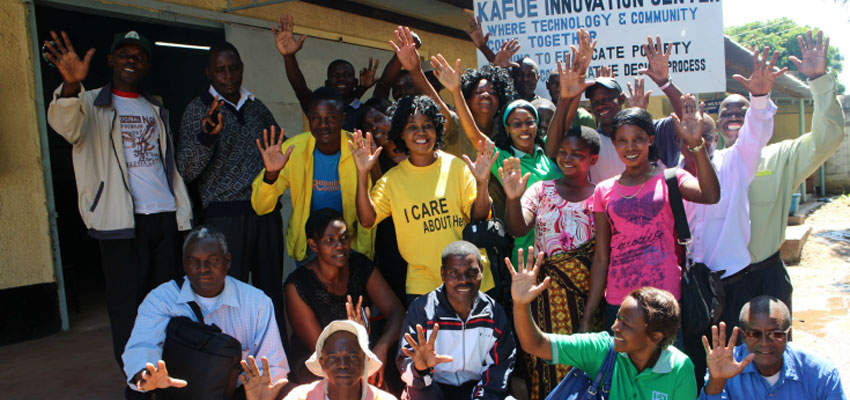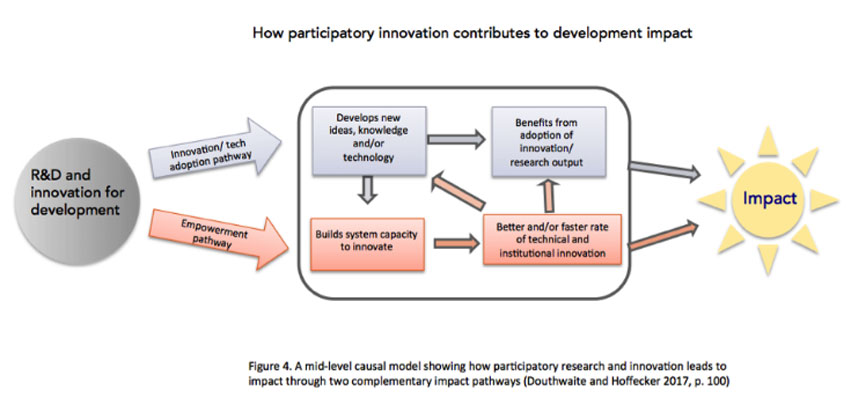
Among global organizations promoting innovation as a strategy for addressing development challenges, there is a common narrative about how innovation can improve the lives of people living in poverty. This narrative is represented in a linear logic model, which portrays a “pipeline” in which a transformative idea moves from concept, to prototype, to testing, and ultimately to adoption and dissemination throughout a target population.
The impact of the innovation is assumed to result from the adoption and use of the innovation by members of the target population. In this model, the path to increasing impact of an innovation is to have it adopted by as many people as possible. This model, commonly used by international donor agencies, multilaterals, and foundations, puts the emphasis on “scaling” the process by which an innovation is rolled out to an ever-larger number of end-users or beneficiaries within a target region. At the 2014 MIT Scaling Development Ventures Conference, the charismatic founder of iDE and author of Out of Poverty, Paul Polak, provocatively instructed the audience of young social entrepreneurs: “If you can’t sell 100 million of your product, don’t bother trying.”
While reaching widespread scale is one meaningful path to development impact, the singular focus on scale promoted by the pipeline model of innovation can obscure other valuable pathways through which innovation creates development impact. In particular, process impacts related to how innovations are developed and disseminated can be easily overlooked when measurement and reporting frameworks are based on the linear logic of the pipeline model. External evaluators, donors, and development agencies can clearly communicate the value of programs that bring innovations to large numbers of end users but often struggle to assess and articulate the value of participatory and capacity-building approaches to innovation, which seek to create impact through both the process and the products of innovation.
The need for better theories of change
There has been growing recognition in the past several years of the need to develop alternate models that better describe how community-based, participatory innovation processes create development impact. This is particularly the case for rural innovation processes, which operate in contexts governed by the dynamics of complexity. In these contexts, interventions can not be expected to create predictable, linear outcomes and impacts, yet all too often programs are required to articulate their value in these terms, following a logic derived from the pipeline model of innovation.
In the past couple of years, some practitioners and scholars have begun to call for the development of “complexity-aware” impact models that better describe these contexts — and which could better serve these programs — yet very few examples currently exist of what this might look like in practice. As a result, participatory innovation programs often find themselves defaulting to the familiar, yet inaccurate, pipeline model for lack of a better alternative.
In a peer-reviewed paper, Towards a complexity-aware theory of change for participatory research programs working within agricultural innovation systems, which was published this week in the journal Agricultural Systems, my co-author Boru Douthwaite and I took on this challenge. We examined two cases of successful participatory innovation processes, one in Zambia and one the Philippines, and identified the causal mechanisms leading to key outcomes in each case. We then looked across the cases to derive a model that depicts the common paths to impact (or “impact pathways” as we call them) present in both cases. From this, we developed a simple causal model to illustrate the alternate pathways through which participatory innovation activity produced development impact in the cases we researched (the version below is slightly updated from that which appears in the paper).

This model identifies two complementary impact pathways, the familiar “innovation adoption pathway” as well as a less familiar “empowerment pathway,” which builds local capacity to engage with—and ultimately to lead—local processes of innovation and technology development. In the cases we researched, these two pathways operated in tandem: the participatory nature of the innovation process resulted in the development of novel technical solutions, but also built the capacity of numerous local stakeholders to engage with and promote processes of technical and institutional innovation. This enhanced local “system capacity to innovate” in turn contributed to more effective solution development and greater success in achieving dissemination, uptake, and use of the resulting innovations (a fuller description can be found in the paper, which is available for free viewing and download for the next 30 days).
Towards complexity-aware theories of change
In developing this model, we found that it is challenging to create impact models that strike the right balance between accuracy (in terms of depicting how impact is actually produced through complexity dynamics such as feedback loops) and usability in terms of being visually clear and communicable. For the purposes of this paper, we erred on the side of simplicity and usability, since our objective was to identify alternate pathways and causal mechanisms through which participatory innovation can create impact in terms of addressing local and regional development challenges.
However, there is still much work to do in terms of developing approaches to modeling that integrate relevant insights and methods from complexity science while producing theories of change that can be used by the organizations and programs who need them. We see our effort as an initial attempt in this direction and hope others join us in puzzling through how to create impact models that more accurately reflect how change happens in the dynamic, unpredictable contexts in which we work.
If you have been working on developing non-linear theories of change for participatory innovation initiatives (or non-linear models of development impact more broadly) we encourage you to share your experiences and join the conversation. Through which impact pathways do you see community-based innovation efforts contributing to local change? How are you experimenting with depicting or modeling these pathways? What kind of visual tools enable complex dynamics to be communicated clearly and effectively? We look forward to exploring these topics over the coming months and learning together how to create more useful and accurate models of the ways in which community-based innovation efforts can create transformative change.
Elizabeth Hoffecker leads MIT D-Lab's research on local innovation and development and is the Research Manager for the International Development Innovation Network (IDIN), a global consortium headquartered at MIT D-Lab.

